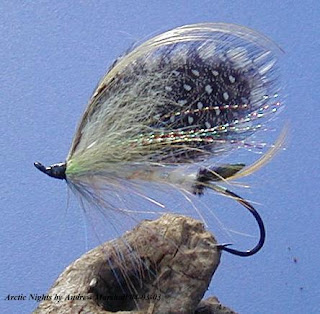Sir Pete Graf
 Hook: Partridge CS10/1
Hook: Partridge CS10/1Tag/tip: flat gold tinsel, tied well forward of the point, low water style.
Tail: yellow golden pheasant flank
Butt: black ostrich
Body: rear 2/3 flat gold tinsel, veiled above and below with hooded merganser crest and butted with black ostrich, front 1/3 black seal
Rib: over gold, 2 strands of fine oval silver wound cross ribbed to each other, over seal; medium oval silver
Hackle: long white coch-a-bondhu over seal only
Throat: speckled guinea
Wing: two hooded merganser flanks, topping over
Cheeks: hooded merganser crest
Head: red
Hooded Merganser has a lovely dusty cinnamon look to it that lemon wood duck and similar ducks do not have. The bicoloured crest also is a superb addition to the repertoire of a salmon fly tier, making a unique and good cheek or tailing and body veil, in my opinion.
In designing this fly, I was after a bright fly for a bright day, with good low-water characteristics for use as a summer run steelhead fly. The gold tinsel body with black and white veilings, go well with the black and white of the fore-body. The wing of course compliments the whole thing by accentuating the gold, black and white with out being over the top. These colours should work pretty much anywhere I would think.

















